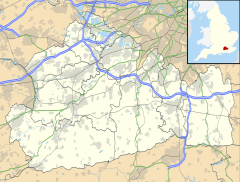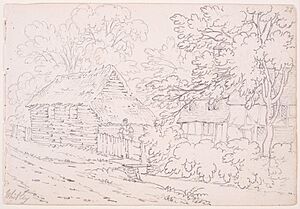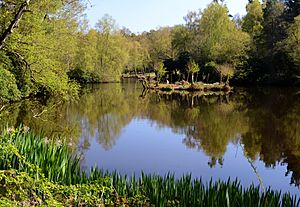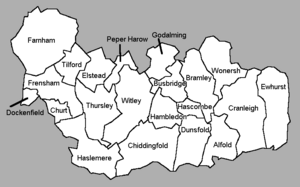Witley facts for kids
Quick facts for kids Witley |
|
|---|---|
| Village | |
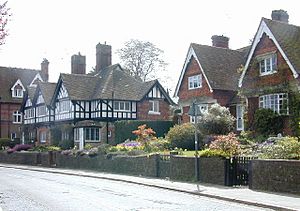 Typical Houses of Petworth Road, Witley |
|
| Area | 27.76 km2 (10.72 sq mi) |
| Population | 8,130 (Civil Parish 2011) |
| • Density | 293/km2 (760/sq mi) |
| OS grid reference | SU947398 |
| • London | 33.5 miles (53.9 km) |
| Civil parish |
|
| District | |
| Shire county | |
| Region | |
| Country | England |
| Sovereign state | United Kingdom |
| Post town | Godalming |
| Postcode district | GU8 |
| Dialling code | 01428 |
| Police | Surrey |
| Fire | Surrey |
| Ambulance | South East Coast |
| EU Parliament | South East England |
| UK Parliament |
|
Witley is a village in Surrey, England. It's located about 2.6 miles (4 km) southwest of Godalming and 6.6 miles (11 km) southwest of Guildford. Witley is part of the Waverley area.
The land around Witley is a mix of countryside and areas that look more like a suburban town. You'll find woodlands, protected by the Surrey Hills AONB, and also cultivated fields. In 2011, the area had a population of 8,130 people.
Witley is part of a larger area called a civil parish. This parish is special because it includes the small town of Milford. In 2023, the parish was renamed "Witley and Milford".
Witley Common is a large open space owned by the National Trust. The A3 road cuts through it. Witley has two train stations nearby: Witley station and Milford station. Both are on the Portsmouth Direct Line. The village church is very old, dating back before the Norman Conquest. Witley is also home to King Edward's School, a private boarding and day school founded in 1553.
Contents
A Look Back in Time
Witley has a long and interesting history. Many of its stories are told through its old buildings and places.
The village is mentioned in the Domesday Book of 1086. This was a huge survey ordered by William the Conqueror. In the Domesday Book, Witley was called Witlei. It was owned by Gislebert, son of Richere de L'Aigle. The survey noted it had a church, fields for farming, meadows, and woodlands. It was quite a valuable place back then!
In 1848, a book called "topographical dictionary of England" described Witley. It said Witley had 1,488 people and covered 6,324 acres (2,559 ha). This included land for crops, pastures for animals, woods, and some infertile land. The book also mentioned the old church and a fair held every year.
Historians have written a lot about Witley's past. In medieval times, much of the land was owned by important families or nobles. These large estates were called manors. Witley had several manors, with three being especially important.
Witley Manor's Story
Before the Norman Conquest, Earl Godwin, father of Harold Godwinson, was the owner of Witley Manor. After the Normans arrived, it was held by Gislebert. Over the centuries, Witley Manor changed hands many times. Sometimes, it was given to nobles by the King. Other times, it went back to the King if the owner had problems or no heirs.
For example, Peter of Savoy, an uncle of Queen Eleanor, once owned this land. Later, Queen Isabella, wife of Edward II of England, owned it. Then, Philippa of Hainault, wife of Edward III of England, received it.
Many famous people were connected to Witley Manor. James Fiennes, 1st Baron Saye and Sele, a soldier, held it. Later, Jasper Tudor, the King's brother, owned it. Even George Plantagenet, 1st Duke of Clarence, brother of Edward IV of England, had it for a time. Eventually, the manor was sold to people who were not nobles.
Lea Park, also known as Witley Park
The history of Lea Park is linked to Witley Manor. This large estate was once a royal park. In 1791, it was sold to William Smith of Godalming. Later, in 1876, it was sold to the Earl of Derby.
It was then bought by Whitaker Wright for a huge sum of £250,000. He built a very grand house there in the 1890s. It was one of the most luxurious private homes in the world! The grounds had three connected lakes and even an amazing underwater billiard room. Sadly, the main house burned down in 1953. Today, the grounds and other buildings are private family homes.
Oxenford Grange
Oxenford Grange was another important estate. It was part of the Peper Harow Park but located in Witley parish. It also changed hands many times over the centuries. After the Dissolution of the Monasteries, it was given to Sir William Fitz William. Later, it was owned by families like the Browness and the Hones.
In the 1800s, George Brodrick, 4th Viscount Midleton owned part of it. His son hired a famous architect, Augustus Welby Northmore Pugin, to build a farm that looked like it was from the 13th century.
Important Landmarks
- All Saints' Church: The oldest parts of this church were built before the Norman Conquest, around the early 1000s. The Normans later made it bigger, giving it a cross shape and adding the tower. The church is a Grade I listed building, meaning it's very important historically. Its graveyard has 13 war graves.
- Witley Park: This was the home of Whitaker Wright. It was built in the 1890s and cost a lot of money. It was famous for its amazing features, like the underwater billiard room. The main house was destroyed by fire in 1953.
- Old Cottage and Step Cottage: These are very old houses near the church. They date back to the 1400s and 1500s.
- White Hart Pub: This village pub is mostly from the Elizabethan era. People say it stands on the site of an even older Saxon inn.
Semaphore Station
On Bannicle Hill, there used to be a special station. It was built in 1822 as part of a semaphore line. This was a system of tall towers with movable arms that sent messages like a visual telegraph. It connected the Admiralty in London to Portsmouth.
A writer named William Cobbett mentioned this station in his book Rural Rides. He described it as a "Telegraph house, stuck up at public expense upon a high hill." Today, there is no trace of the station left.
| Next station upwards | Admiralty Semaphore line 1822 | Next station downwards |
| Pewley Hill | Bannicle Hill | Haste Hill |
Geography of Witley
Witley is a village in the Borough of Waverley in Surrey. It's located southwest of Godalming and Guildford. The village is just east of the A3 highway, which goes from London to Portsmouth. London is about 33.5 miles (53.9 km) northeast.
The Witley area includes the large village of Milford to the north. It also has smaller areas like Sandhills and Brook. Many of these areas are connected by roads and buildings, forming a wide arc. This arc is surrounded by Witley Common or by streams and lakes.
The local council for Witley and Milford helps manage the area. They look after things like the recreation ground, allotments (small plots of land for gardening), and village halls. They also help organize community events.
Witley Common
Witley Common is a large area of open land that belongs to the National Trust. It's right next to many parts of the village. The A3 highway, which has two lanes in each direction, cuts through it.
Local Areas
Witley parish includes several smaller areas. Five of these form a group: Cramhurst, Wheelerstreet, Crossways, the historic center of Witley, and Culmer. These areas are close together, though some fields separate them.
Other parts of the parish include Sandhills, Brook, and most of Wormley.
Education
- Witley Infants School: This school is located opposite the church. It's a good example of a 19th-century school building, built in 1836.
- King Edward's School: This is a private school located just south of the village center. It's a well-known boarding and day school.
Transport
- Train Stations: The village is served by Witley railway station. People living in the northern part of the village might find Milford railway station closer. Both stations are on the Portsmouth Direct Line, which connects London to Portsmouth.
Famous People from Witley
Many interesting people have lived in or been connected to Witley:
- Peter II, Count of Savoy (1203-1263): He was a Lord of the Manor of Witley in the 1200s.
- Lionel of Antwerp (1338–1368): A Duke and brother of King Edward IV, he was also a lord of Witley Manor. Other famous owners included Godwin, Earl of Wessex (father of King Harold) and King Edward I's wife, Queen Margaret.
- Herbert Pease (1867–1949): A British politician who became Baron Daryngton of Witley.
- David Lloyd George (1863–1945): A former Prime Minister of the UK, he had a house in Witley called Timbers where he could relax.
- Terry Scott (1927–1994): A famous comedian known for the TV show Terry and June, he lived in the village.
- Myles Birket Foster (1825–1899): An artist buried in the churchyard.
- George Eliot (1819–1880): A famous English novelist who spent her last years in Witley.
- Gertrude Mary Tuckwell (1861–1951): A trade unionist and social reformer who lived her final years here.
- James John Joicey (1870–1932): An amateur expert on insects and owner of the Hill Museum.
- Frederick Williamson (1835–1900): A visual artist known for his paintings of landscapes with sheep, buried in the churchyard.
- Raymond Frederick Brown: The founder of the company Racal.
- Tony Banks (born 1950): A founding member and keyboard player of the famous rock band Genesis.
Population and Homes
Witley is a busy place with many homes.
| Output area | Detached | Semi-detached | Terraced | Flats and apartments | Caravans/temporary/mobile homes | shared between households |
|---|---|---|---|---|---|---|
| (Civil Parish; includes town of Milford in the north) | 1,187 | 982 | 491 | 501 | 10 | 2 |
In the Witley and Milford parish, many homes are detached houses (standing alone). There are also semi-detached houses (joined to one other house), terraced houses (joined in a row), and flats or apartments. A small number of people live in caravans or mobile homes.
| Output area | Population | Households | % Owned outright | % Owned with a loan | hectares |
|---|---|---|---|---|---|
| (Civil Parish) | 8,130 | 3,173 | 36.2% | 36.7% | 2,776 |
In 2011, the civil parish had a population of 8,130 people living in 3,173 households. About 36.2% of households owned their homes completely, and 36.7% owned their homes with a loan. The rest of the homes were rented.
See also
 In Spanish: Witley para niños
In Spanish: Witley para niños


